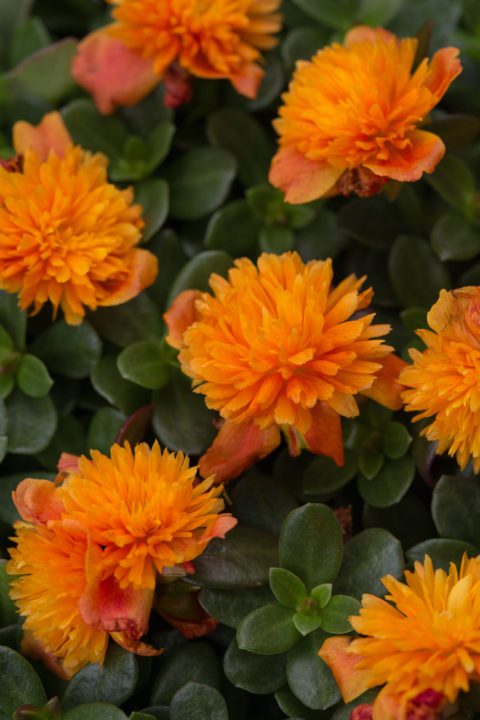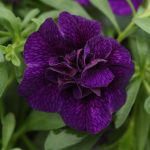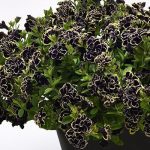Purslane, SeaGlass Double Orange
$8.99
Discount per quantity
| Quantity | 3 - 8 | 9 - 14 | 15+ |
|---|---|---|---|
| Price | $8.72 | $8.45 | $8.09 |
| % Discount | 3% | 6% | 10% |
Description
SeaGlass Double Orange Purslane – A Sun-Kissed Treasure for Every Garden
Welcome to the Glow
You and I know the thrill of finding a plant that blooms like a sunrise, asks for almost nothing, and still rewards us day after day. SeaGlass Double Orange Purslane does exactly that. Its flowers gleam like bright beads washed smooth by waves. Its leaves stay tidy and thick. It shines under fierce heat where many plants wilt. In other words, it is a summer gem.
Use this guide as your friendly map. We will explore what makes this purslane special, where it fits best, and how we can help it thrive. By the end, you will feel ready to tuck SeaGlass Double Orange into beds, pots, and even tiny cracks between stones. Let’s begin.
Meet the Plant – Description
Bloom Color and Shape
SeaGlass Double Orange bursts open with layered petals, much like a tiny rose. Each flower glows a deep tangerine tone that softens toward the center. The double form means more petals per bloom, so every blossom looks plush and full. Flowers appear as early as late spring and keep going until the first fall frost.
Growth Habit and Size
Expect plants to stay low—about 6 to 8 inches tall—but spread in a relaxed, cascading way. Stems can reach 14 to 18 inches long, spilling gracefully over the rim of a pot or flowing across a sunny path edge. Because SeaGlass Double Orange branches freely, it forms a thick mat that covers soil and crowds out weeds. Instead of stretching upward, it hugs the ground and fills space fast.
Foliage Texture
Leaves are small, smooth, and fleshy—classic signs of a succulent. They store water like tiny canteens, so the plant keeps its bounce even when days turn dry. The foliage stays a cool, jade green. That steady color lets the fiery flowers steal the show without clashing.
Special Strengths
- Heat hero: Blooms hold bright color even when midday temperatures climb past 95 °F.
- Drought tough: Its succulent leaves sip water slowly, which means less hose time for you.
- Self-cleaning: Spent petals drop on their own. No need to deadhead.
- Pollinator-friendly: Bees and butterflies visit for nectar, though petals stay tidy and never feel messy.
Why We Love SeaGlass Double Orange
- It gives high-impact color with almost no upkeep.
- It thrives in containers, window boxes, and hanging baskets where other plants might dry out.
- It turns blank, hot corners—think driveway edges, mailbox beds, or rocky slopes—into glowing tapestries.
- After more than a day of rain, it shakes off moisture instead of sulking.
- Children delight in its silky petals and how they close at dusk, like little lamps flicking off for the night.
But most of all, SeaGlass Double Orange invites us to relax. We water less, worry less, and spend more time enjoying the show.
Planting Basics – Getting Started Right
When to Plant
Wait until night temperatures stay above 55 °F. In many regions, that means late spring. Transplants take off swiftly once soil warms. Seed is rare for this variety, so most of us buy young starts in packs or pots.
Picking the Perfect Spot
Choose full sun. Six hours of direct light is the bare minimum. Eight or more hours is ideal. Light fuels those brilliant blooms. Shade will cut flower count and leave plants lanky.
Soil Check
SeaGlass Double Orange likes fast-draining soil. Sandy loam is perfect. Heavy clay? Loosen it with fine gravel and compost. Raised beds, rock gardens, and container mixes also work well. Keep pH slightly acidic to neutral, around 6.0 to 7.0.
Spacing
Set plants 10 to 12 inches apart. They will touch quickly and form a seamless mat. In pots, one to three plants can fill a 12-inch container within weeks. Let stems trail over the rim for a carefree look.
Everyday Care – Helping the Jewel Shine
Sunlight
Give full, blazing sun. Flowers open widest in bright light and may stay closed on cloudy days. More sun means more color.
Water
Water the first week to settle roots. After that, soak deeply but seldom. Allow soil to dry between drinks. In hanging baskets, we may water a bit more, yet still let the mix dry on top before the next soak.
Feeding
Purslane is naturally thrifty. A light, balanced fertilizer once a month keeps foliage green and blooms abundant. Use a half-strength liquid feed or mix a slow-release, all-purpose granular into the potting mix at planting time. Too much nitrogen can spur leaves over flowers, so go easy.
Soil Drainage
Standing water is the enemy. When roots sit in soggy soil, they suffocate. Make sure containers have holes, and never place a saucer under pots outdoors. In beds, raise the planting area a couple of inches above surrounding soil to improve runoff.
Mulch
A thin layer—no deeper than half an inch—of fine gravel or coarse sand protects roots and echoes the plant’s natural, arid habitat. Avoid thick organic mulches, which hold dampness and can cause rot.
Grooming and Pruning
Even though SeaGlass Double Orange is self-cleaning, you may pinch back wayward stems to keep edges neat. Use your fingers or clean scissors. Pinching also encourages new side shoots, which carry more flowers. If plants become too thick by mid-summer, cut them back by one-third. Within two weeks they regrow lush and blooming.
Pest and Disease Defense
Good news: problems are rare. Still, let’s stay watchful.
| Issue | Signs | Simple Fix |
|---|---|---|
| Root rot | Wilting despite moist soil | Improve drainage. Let soil dry fully. |
| Aphids | Sticky leaves, small green insects | Rinse with a firm water spray. Use insecticidal soap if needed. |
| Spider mites | Fine webbing, tiny specks | Increase humidity with overhead misting. Treat with neem oil. |
Because the plant loves heat and low moisture, fungal leaf spots almost never appear. Airflow and sun act as natural shields.
Overwintering Tips
SeaGlass Double Orange is tender. Frost will end outdoor growth. In USDA zones 9 to 11, plants may overwinter in the ground with only light protection. In cooler zones, treat it as an annual or bring cuttings inside:
- Snip 3-inch tips before first frost.
- Let cut ends dry one day.
- Stick into moist, sandy mix under bright light.
- Water lightly, just enough to prevent shriveling.
We can keep rooted cuttings on a sunny windowsill all winter. Come spring, re-plant outdoors.
Design Ideas – Playing With Color and Form
Containers and Baskets
Pair SeaGlass Double Orange with trailing lime sweet potato vine. The neon chartreuse leaves frame the hot orange blooms like a glowing border. Another option is blue-green sedum for a cool contrast.
Rock Gardens
Tuck stems among stones. The plant’s spreading habit softens hard edges. Its drought tolerance means fewer trips with the watering can.
Groundcover Under Taller Plants
Let it sprawl beneath elephant ears, cannas, or dwarf palms. The low mat hides bare soil, conserves moisture, and adds dazzling color below bold foliage.
Mixed Sun-Loving Bed
Combine with yellow lantana, red zinnia, and white vinca. The result is a three-month fiesta of flowers that butterflies adore.
Propagation Made Simple
Purslane roots easily from cuttings. Even a single leaf node on a stem can form roots in just one week. Here’s a quick method:
- Cut a non-flowering stem tip 4 inches long.
- Remove lower leaves.
- Push the bare node into moist potting mix.
- Place in bright, indirect light.
- Mist lightly every other day.
Roots appear fast. Once growth kicks in, shift the new plant to full sun and regular care. We can multiply a single mother plant into dozens this way, perfect for big projects or gifts to friends.
Quick Questions You Might Ask
Does SeaGlass Double Orange seed itself?
Rarely. The double flowers are mostly sterile. Your beds will stay tidy without unwanted volunteers.
Are the leaves edible like common purslane?
Yes, but flavor can be bitter, and plants sold for ornament may have been treated with chemicals. If you wish to taste, grow organically and sample only fresh, unsprayed leaves.
Why do my flowers close each night?
Purslane blooms respond to light and heat. They close at dusk and on cloudy days. More sun brings longer open hours.
Can I grow it indoors?
Flowers need intense light to form. Indoor growing is tricky unless you use full-spectrum grow lights for 14 hours daily. For most of us, SeaGlass Double Orange shines best outdoors.
Is it safe around pets?
In small amounts, purslane is not harmful to most dogs or cats, but large servings could upset tummies due to oxalates. Place containers out of reach if your pets nibble plants.
Shared Joy Ahead
SeaGlass Double Orange Purslane invites us to relax under the sun while it does the hard work of glowing, sprawling, and charming everyone who passes by. With simple soil, bright light, and a splash of water now and then, it rewards us with months of vivid blooms. Whether you tuck it into a seaside pot, a city balcony, or a rugged rock wall, this plant turns ordinary spaces into warm, cheerful scenes. So let’s plant, water, and watch the magic unfold.
Radiant Paths Await
Additional information
| Weight | N/A |
|---|---|
| Options | Starter Plug – 3 count, 4 in. (16.9 fl. oz.) Pot |





